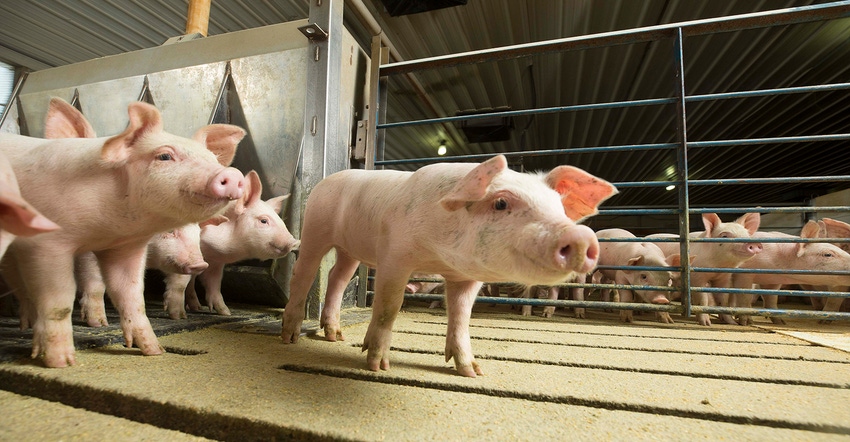ISU searches for genetic links to improve crop, livestock breeding
Researchers to examine data on 4,500 feeder pigs who went through a disease challenge including growth rates and daily feed and water intake.
November 9, 2023

When a hurricane-like derecho knocked down corn plants across Iowa in August 2020, it was devastating for farmers. But it also presented a natural experiment for an Iowa State University research team, which fanned out across flattened fields in the days after the storm to record how crops held up.
High winds caused widespread lodging, which happens when a corn plant’s stalk breaks or its roots fail to keep it upright. The genetic makeup of corn stalk strength is well-studied, but little research has looked at what makes roots more resistant to lodging. By analyzing post-derecho observations of their genotyped test plots, searching for hereditary causes of root lodging, Iowa State researchers identified 118 genes that may affect corn root stability.
“That storm was such a disaster, so it was exciting to be able to make some lemonade out of lemons,” said Patrick Schnable, Baker Professor in Agronomy and Iowa Corn Promotion Board Endowed Chair in Genetics.
The root lodging study is an example of how advanced statistical analysis can help mine the expanding volumes of data collected by crop and livestock breeders, hunting for hard-to-spot relationships between the genetic code and complex traits that matter. An interdisciplinary research team at Iowa State recently won a $1.1 million grant from the USDA to probe existing data for previously unseen links between the genetic instructions carried by plants and animals (genomes) and their physiological characteristics (phenomes).
Genetics is the cornerstone of breeding, but genomes-to-phenomes research powered by innovative statistical analysis and modeling can provide deeper insight that will be essential to meeting future agricultural production needs, said Schnable, one of the project leads.
“There are enormous challenges facing the world in terms of food supply. Agriculture was invented in a world different than the one we’ll be facing in the coming decades,” he said.
Developing crops and livestock that are more resilient to diseases and changing weather conditions is complex and urgent, said distinguished professor of animal science Jack Dekkers, a co-investigator on the grant. Deeper data analysis can speed up adaptation efforts.
“Breeding progress comes faster when you have a better understanding of the genetic basis of the traits you’re trying to improve,” Dekkers said.
Statistical detective work
The statistical detective work of searching for associations between genomic and phenomic data sets often tangles with environmental variation and other confounding factors. In the study of the derecho-downed corn, which is not part of the new grant, researchers initially weren’t able to detect the genetic causes of root lodging. Statisticians only found the genes of interest after including in their models the condition of neighboring plants, which impacted the effects of the extreme winds, Schnable said.
Associate professors of statistics Vivekananda Roy and Somak Dutta analyzed the post-derecho corn data and are co-investigators on the new grant. Their models integrate multiple methods of scanning large data sets, account for numerous sources of variation and employ strategies for more efficient processing. Their approach is like knowing the Dewey Decimal System when you’re looking for a library book instead of searching shelf-by-shelf, Roy said.
“If you know how the books are arranged, that’s a lot better,” he said.
Six ISU research teams have been identified to participate in the three-year project, which is funded through the USDA’s National Institute of Food and Agriculture. Dekkers said his data on 4,500 feeder pigs who went through a disease challenge includes growth rates and daily feed and water intake as well as genotypes of 450,000 genetic markers across the genome. For half the subjects, he also has data on expression of about 14,000 genes in blood prior to the disease challenge.
“It takes sophisticated statistical tools to make sense of data this detailed,” he said.
Just the start
The new grant builds on the work of the Agricultural Genomes to Phenomes Initiative, a project led by a group of researchers at Iowa State and other institutions that includes Schnable and Dekkers. AG2PI’s aim was cultivating a genomes-to-phenomes community among crop and livestock researchers by distributing USDA seed grants and holding conferences, workshops and field days. That education and training will continue with the new grant. Techniques developed for the project will be shared with colleagues and incorporated into some Iowa State courses.
Project leaders hope this is just the beginning of an explosion in genomes-to-phenomes research in agriculture. It’s a cost-effective way of leveraging existing research to help farmers continue to feed the world.
“A lot of money has already been invested in creating these data sets. The analysis to extract more knowledge from the data is much less expensive,” Dekkers said.
You May Also Like



